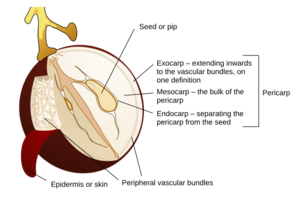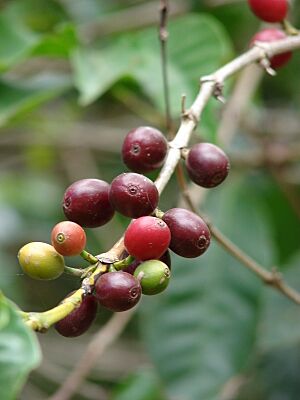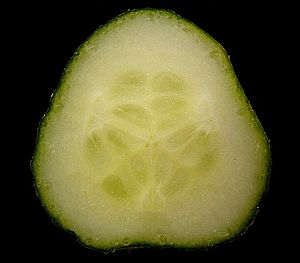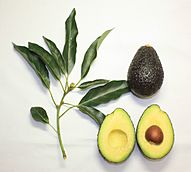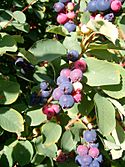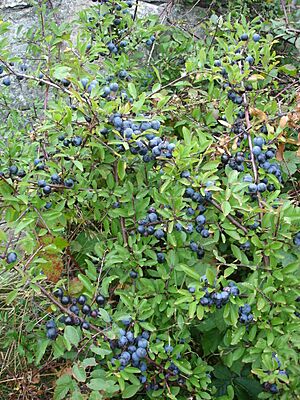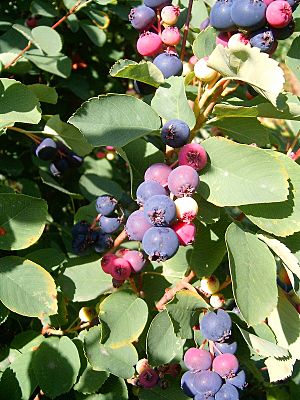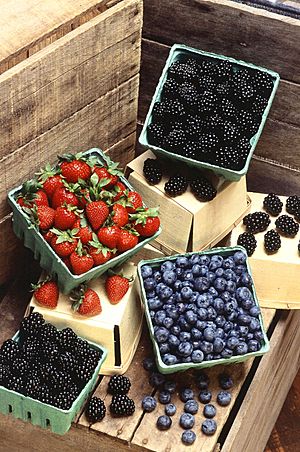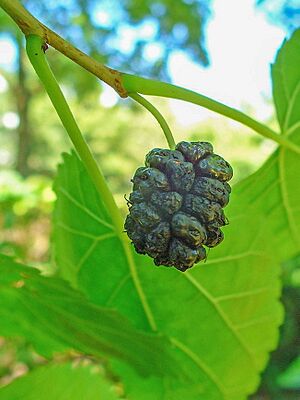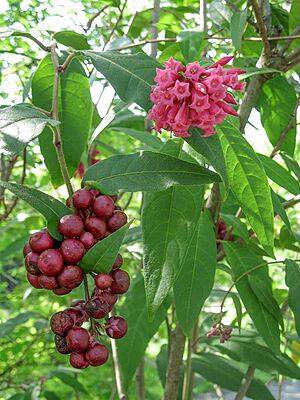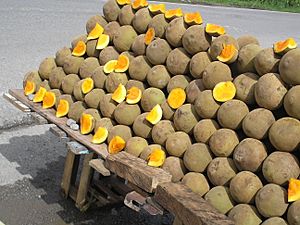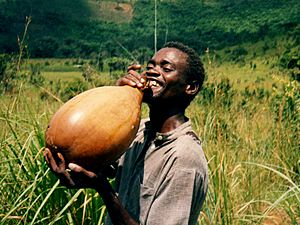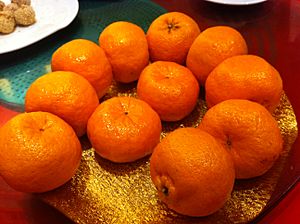Berry (botany) facts for kids
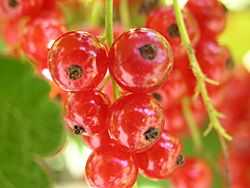
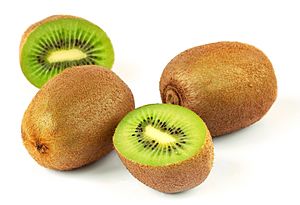
A berry is a type of fleshy fruit that grows from a single flower. In botany (the study of plants), a berry is defined as a fruit that doesn't have a hard stone (or pit) inside. It comes from a single ovary of a flower.
Some fruits that are botanically berries include grapes, currants, and tomatoes. Even cucumbers, eggplants, and bananas are considered berries by botanists! However, fruits like strawberries and raspberries, which we often call berries in everyday life, are not true berries in botany.
Berries are the most common type of fleshy fruit. Their entire outer layer, called the "pericarp", ripens and can often be eaten. The seeds are usually inside the fleshy part. While many berries are safe to eat, some, like the fruits of the potato plant or the deadly nightshade, are poisonous to humans.
If a plant grows berries, it's called bacciferous or baccate.
In everyday language, a "berry" is just any small, edible fruit. These are usually juicy, round, brightly colored, and taste either sweet or sour. They don't have a big stone, but they might have many small seeds.
Contents
What is a Botanical Berry?
In botany, a berry is a simple fruit. It has seeds and soft, fleshy pulp (the pericarp) that grows from the ovary of a single flower. The ovary can be either inferior (below other flower parts) or superior (above other flower parts).
A true berry does not split open when it's ripe to release its seeds. The pericarp (fruit wall) has three layers:
- The outer layer is the "exocarp" or "epicarp" (the skin).
- The middle layer is the "mesocarp" or "sarcocarp" (the fleshy part).
- The inner layer is the "endocarp" (the part closest to the seeds).
The main difference between a berry and a drupe (like a peach) is the endocarp. A drupe has a hard, stony endocarp around its seed. In a berry, the endocarp is usually soft or very thin.
Here are some examples of fruits that are true botanical berries:
- Avocado (sometimes also called a drupe)
- Banana
- Barberry and Oregon-grape
- Strawberry tree (not the common strawberry!)
- Bearberry, bilberry, blueberry, cranberry, lingonberry, crowberry
- Coffee berries (also sometimes called drupes)
- Gooseberry and currant (red, black, and white types)
- Aubergine/Eggplant, tomato, goji berries (wolfberry)
- Elderberry
- Indian gooseberry
- Garcinia gummi-gutta, Garcinia mangostana (mangosteen)
- Sapodilla
- Grape
- Honeysuckle (some types are edible, others are poisonous)
- Persimmon
- Pumpkin, cucumber, and watermelon
Different Kinds of Berries
Some berries have special names because of how they look or grow:
- Hesperidium: This is the name for citrus fruits like oranges, kumquats, and lemons. They have a thick rind (skin) and a very juicy inside divided into segments.
- Pepo: This term is used for fruits in the gourd family, like cucumbers, pumpkins, and watermelons. They have a hard outer rind but are not divided into segments inside.
Berries that grow from an inferior ovary (where the flower parts are above the ovary) are sometimes called "false berries" or "epigynous berries." This is because other parts of the flower, besides the ovary, become part of the fleshy fruit. Examples include bananas, coffee berries, blueberryes, cranberryes, and fruits from the gourd family.
Fruits That Look Like Berries (But Aren't!)
Many fruits we call "berries" in everyday English are not true berries in botany. Here are some examples:
Drupes
Drupes are fleshy fruits that usually have a single seed surrounded by a hard, woody layer called the endocarp. Think of peaches, plums, cherries, olives, and dates. Even coconuts are drupes! Some definitions say a drupe must have an endocarp thicker than 2 mm.
Pomes
Pomes are fruits like apples and pears. They have a "core" where tough tissue separates the seeds from the softer outer fruit. Pomes are not berries. However, some small pomes, like serviceberries, can look and feel like blueberries when ripe.
Aggregate Fruits
Aggregate fruits come from a single flower that has many separate ovaries. These small "fruitlets" join together as they ripen to form one fruit. Blackberries and raspberries are common examples of aggregate fruits that people often call "berries." Botanically, they are not true berries.
Multiple Fruits
Multiple fruits grow from a cluster of several flowers that are very close together. As these flowers develop into fruits, they merge into one larger fruit. The mulberry is a good example of a multiple fruit that looks like a berry.
Accessory Fruits
In accessory fruits, the main edible part doesn't come from the ovary. A great example is the strawberry. The tiny "seeds" on the outside are actually the true fruits, and the big, red, fleshy part we eat comes from the flower's receptacle (the part that holds the flower). Mock strawberrys are similar.
Berry-like Conifer Seed Cones
Some conifer trees, like yews and junipers, have female seed cones that look like berries. Their scales are fleshy and merged. Juniper "berries" are used to flavor gin. Yew "berries" have a fleshy red part called an aril that partly covers a poisonous seed.
Why is the Definition Confusing?
The way we define fruits in botany has changed over time. Early botanists used the Latin word baca or bacca for any small, round fruit. Different scientists like Carl Linnaeus and Joseph Gaertner tried to create clear rules for classifying fruits, but they didn't always agree.
For example, Linnaeus defined a berry as a fleshy fruit with "naked seeds" inside, meaning they weren't in a hard shell. Gaertner later added terms like pepo for gourd-like fruits. Even today, there isn't one perfect, agreed-upon system for classifying all fruits. This is why the scientific definition of a berry is different from what most people think of as a berry!
How Berries Evolved
Early flowering plants had dry fruits. Fleshy fruits, like berries, appeared much later, about 66 million years ago. Scientists think that the evolution of fleshy fruits was helped by animals, like mammals and birds, that eat fruit and then spread the seeds.
Fleshy fruits are also common in moist places with lots of trees, where wind can't spread dry seeds as easily. So, the change in fruit types might have led to more animals eating fruit, or the animals might have encouraged the plants to grow fleshy fruits.
Scientists study how berries evolved in different plant families. For example, in the Solanaceae family (which includes tomatoes and eggplants), berries seem to have evolved at least three separate times. This shows that fruits that look like berries might not have the exact same evolutionary history or structure.
Uses of Berries
Berries, in the general sense, have been an important food source for humans for a very long time, even before farming began. They are also a main food for other primates.
Here are some culinary uses of botanical berries:
- True berries: Bananas, blueberries, cranberries, coffee berries, gooseberries, currants, tomatoes, grapes, and peppers.
- Hesperidia: Citrus fruits like oranges, lemons, and limes.
- Pepos: Gourds, cucumbers, melons, and watermelons.
Many berries are brightly colored because of natural plant pigments like anthocyanins. These pigments are often found in the skin and seeds. While these pigments are good for the plant, there's no strong proof that they have special health benefits for humans when eaten.
Some spices come from berries. For example, Allspice is made from dried berries. Different types of Capsicum annuum fruits are used to make paprika, chili pepper, and cayenne pepper.
Other Uses
The hard outer rind of pepos (like bottle gourds) can be dried and used as containers. The English name "bottle gourd" shows this use.
Some true berries have also been used to make dyes. In Hawaii, berries from a plant called Dianella were used to make blue dye, and berries from black nightshade were used for green dye.
History of Cultivation
Some of the earliest plants grown by humans were botanical berries.
- Gourds (pepos) were domesticated over 9,000 to 13,000 years ago in the Americas and Asia.
- Peppers were domesticated in Central America about 8,000 years ago.
- Grapes were domesticated 8,000 years ago and used to make wine 6,000 years ago.
- Bananas were first grown in Papua New Guinea and Southeast Asia at least 7,000 years ago, possibly even 10,000 years ago.
- The history of citrus fruit is less clear, but mandarins and pomelos were grown in China around 4,200 years ago.
Commercial Production
In 2013, four of the top five most produced fruits in the world (by weight) were botanical berries. The other was apples, which are pomes.
| Name | Thousands of tonnes | Fruit type |
|---|---|---|
| Bananas & plantains | 144,592 | Berry |
| Citrus fruit† | 135,761 | Berry (hesperidium) |
| Watermelons | 109,279 | Berry (pepo) |
| Apples | 80,823 | Pome |
| Grapes | 77,181 | Berry |
†Citrus fruit includes oranges, lemons, limes, grapefruit, tangerines, mandarins, clementines, and satsumas. Oranges make up 53% of the total.
In 2012, bananas and citrus fruits were also the top two most exported fruits by weight.
| Name | Thousands of tonnes | Fruit type |
|---|---|---|
| Bananas & plantains | 19,725 | Berry |
| Citrus fruit† | 15,262 | Berry (hesperidium) |
| Apples | 8,271 | Pome |
| Prepared fruit‡ | 7,120 | – |
| Grapes | 4,051 | Berry |
†Citrus fruit includes oranges, lemons, limes, grapefruit, tangerines, mandarins, clementines, and satsumas. Oranges make up 43% of the total.
‡"Prepared fruit" means fruit that has been frozen, preserved, or made into jam, paste, or puree.
Images for kids
-
Redcurrants, a type of berry
-
Kiwifruit, a berry
See also
 In Spanish: Baya para niños
In Spanish: Baya para niños


